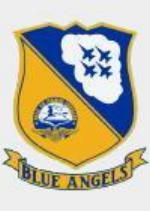Hobby Master HA1409 USN McDonnell Douglas A-4F Skyhawk Attack Aircraft - "The Blue Angels" (1:72 Scale)
" [The US] Navy Flight Exhibition Team thrilled spectators with low-flying maneuvers performed in tight formations, and (according to Voris) by "...keeping something in front of the crowds at all times. My objective was to beat the Army Air Corps. If we did that, we'd get all the other side issues. I felt that if we weren't the best, it would be my naval career."
- Lieutenant Commander Roy Marlin "Butch" Voris, a World War II fighter ace, named Officer-in-Charge and Flight Leader of the US Navy's first flight demonstration squadron
 The A-4 Skyhawk is an attack aircraft originally designed to operate from United States Navy aircraft carriers. Fifty years after the type's first flight, some of the nearly 3,000 Skyhawks produced remain in service with smaller air arms around the world. The aircraft was formerly the A4D Skyhawk, and was designed by the Douglas Aircraft Corporation, later McDonnell Douglas, now Boeing.
The A-4 Skyhawk is an attack aircraft originally designed to operate from United States Navy aircraft carriers. Fifty years after the type's first flight, some of the nearly 3,000 Skyhawks produced remain in service with smaller air arms around the world. The aircraft was formerly the A4D Skyhawk, and was designed by the Douglas Aircraft Corporation, later McDonnell Douglas, now Boeing.
The Skyhawk was designed by Douglas' Ed Heinemann in response to a U.S. Navy call for a jet-powered attack aircraft to replace the A-1 Skyraider. Heinemann opted for a design that would minimize size, weight, and complexity. The result was an aircraft that weighed only half of the Navy's specification and had a wing so compact that it did not need to be folded for carrier stowage. The diminutive Skyhawk soon received the nicknames "Scooter", "Bantam Bomber", "Tinker Toy Bomber", and, on account of its nimble performance, "Heinemann's Hot-Rod."
The Navy issued a contract for the type on June 12th 1952, and the first prototype first flew on June 22nd, 1954. Deliveries to Navy and U.S. Marine Corps squadrons commenced in late 1956.
The Skyhawk remained in production until 1975, with a total of 2,960 aircraft built, including 555 two-seat trainers. The US Navy began removing the aircraft from its front-line squadrons in 1967, with the last retiring in 1975. The Marines would pass on the A-7 Corsair II. The last USMC Skyhawk was delivered in 1979, and were used until the mid-1990s until they were replaced by the similarly small, but V/STOL vertical landing AV-8 Harrier.
Pictured here is a 1:72 scale replica of a USN McDonnell Douglas A-4F Skyhawk attack aircraft that was flown by "The Blue Angels".
Sold Out!
Dimensions:
Wingspan: 4-3/4-inches
Length: 6-3/4-inches
Release Date: June 2008
 Historical Account: "Precision Flying" - The United States Navy's Flight Demonstration Squadron, popularly known as the Blue Angels, was formed in 1946 and is the world's first officially sanctioned military aerial demonstration team.
Historical Account: "Precision Flying" - The United States Navy's Flight Demonstration Squadron, popularly known as the Blue Angels, was formed in 1946 and is the world's first officially sanctioned military aerial demonstration team.
The Blue Angels first flew three aircraft in formation, then four, and currently operate six aircraft per show. A seventh aircraft is for backup, in the event of mechanical problems with one of the other aircraft, and for giving public relations "demonstration flights" to civilians, usually selected from a press pool.
This aerobatic team is split into "the Diamond" (Blue Angels 1 through 4) and the Opposing Solos (Blue Angels 5 and 6). Most of their displays alternate between maneuvers performed by the Diamond and those performed by the Solos.
The Diamond, in tight formation and usually at lower speeds, performs maneuvers such as formation loops, barrel rolls, or transitions from one formation to another.
The Opposing Solos usually perform maneuvers just under the speed of sound which showcase the capabilities of their individual F/A-18 Hornets through the execution of high-speed passes, slow passes, fast rolls, slow rolls, and very tight turns. Some of the maneuvers include both solo F/A-18s performing at once, such as opposing passes (toward each other in what appears to be a collision course, narrowly missing one another) and mirror formations (back-to-back. belly-to-belly, or wingtip-to-wingtip, with one jet flying inverted).
At the end of the routine, all six aircraft join in the Delta formation. After a series of flat passes, turns, loops, and rolls performed in this formation, they execute the team's signature "fleur-de-lis" closing maneuver.
The parameters of each show must be tailored to local visibility: In clear weather the "high" show is performed, in overcast conditions it's the "low" show that the spectators see, and in limited visibility (weather permitting) the "flat" show is presented. The "high" show requires an 8,000-foot (2,400 m) ceiling and visibility of 3 nautical miles (6 km) from the show's centerpoint. "Low" and "flat" ceilings are 3,500 and 1,500 feet (460 m) respectively.


